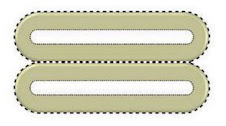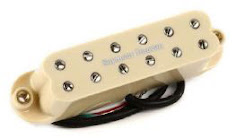A single color mark on a product design is registrable only upon a showing of acquired distinctiveness. Wal-Mart (citing Qualitex). Applicant Dimarzio, Inc. failed to prove that its claimed color "cream" for electronic guitar pickups met that test, and so the Board affirmed a refusal to register under Sections 1, 2, and 45 of the Lanham Act. Among other problems with Dimarzio's evidence, the Board found that its use of the proposed mark was not substantially exclusive, as required under Section 2(f). In re Dimarzio, Inc., 2021 USPQ2d 1191 (TTAB 2021) [precedential] (Opinion by Judge Mark Lebow).

Pagination problem: Dimarzio led off with a sour note when the Board refused to consider its appeal brief because the brief exceeded the 25-page limit of Rule 2.142(b)(2). Examining Attorney Tasneem Hussein blew the whistle, pointing out that the brief was 16-pages long but not double-spaced, as required by Rule 2.126(a)(1). The Board sustained her objection, agreeing that the brief would have exceeded 25 pages if double-spaced (at 250 words per page). The Board, however, did consider Dimarzio's reply brief.
Applicable law: The question at hand was simply whether relevant member of the public - consumers of guitar pickups - understand the primary significance of the proposed mark "as identifying the source of the goods rather than merely ornamenting them." See Milwaukee Elec. Tool Corp., 2019 USPQ2d 460354 at *23. In making that determination, the Board applied the CAFC's Converse factors, noting that no single factor all six factors are to be weighed and no one factor is determinative. See Guaranteed Rate, Inc. 2020 USPQ2d at 10869.
- (1) association of the trade dress with a particular source by actual purchasers (typically measured by customer surveys);
- (2) length, degree, and exclusivity of use;
- (3) amount and manner of advertising;
- (4) amount of sales and number of customers;
- (5) intentional copying; and
- (6) unsolicited media coverage of the product embodying the mark
Converse Inc. v. Int'l Trade Comm'n, 128 USPQ2d at 1546.
Finally, the burden of proof to establish a prima facie case of acquired distinctiveness rests on the applicant. See Yamaha Int'l Corp. v Hoshino Gakki Co. Ltd., 6 USPQ2d at 1004.
Analysis: Although, as noted in Converse, consumer association is usually measured by surveys, Dimarzio did not offer one. Instead it submitted "fill-in-the-blank" declarations from eight different distributors and customers. The Board found them of little, if any, probative value. Aside from their small number, conclusory nature, and lack of identifying information, none of the declarations related to the proposed mark, the color cream. Similarly, Dimarzio's evidence of enforcement activity related to a product configuration mark with color, not color alone.
Dimarzio claimed use of the proposed mark since 1979, with millions of consumers observing its guitar pickups in videos, advertisements, and musical performances. The Board pointed out, however, that long-time use of a supposed mark does not establish that the use is substantially exclusive or that consumers perceive the supposed mark as a source indicator. In fact, the evidence showed that DiMarzio's use of the color cream on guitar pickups was not substantially exclusive (see example of competitor product below).
Dimarzio contended that these competitor products were the wrong shade of cream, but it the color cream was not narrowly defined in its application to register.
As Applicant points out, it did not use a commercial color identification system, such as Pantone, to identify its claimed color. Thus, even if the shades of the third-party cream-colored pickups vary somewhat from Applicant’s self-styled “distinctive” shade, those uses, at minimum, are of a substantially similar shade of cream, i.e., shades close enough in appearance to impair Applicant’s “ability to show that its proposed color mark has acquired distinctiveness in that market.” Milwaukee Elec. Tool, 2019 USPQ2d 460354, at *25.
Moreover, the shades of cream in some of the competitor products are "quite similar" to the shades of cream that Dimarzio considered to be infringing in its enforcement efforts, and the shades of cream actually used by DiMarzia appear to differ from that shown in the application drawing.
Dimarzio also feebly claimed that the third-party uses involved the wrong kind of guitar pickup, but the Board quickly pointed that the goods in the application are identified as "electronic sound pickups for guitar" and are not limited to any particular kind of pickup.
With respect to DiMarzio's marketing efforts, the Board noted the lack of "look-for" advertising but acknowledged that such advertising is not required for a showing of acquired distinctiveness. However, Dimarzio's advertising characterized the color cream as one of many colors available, and so there was nothing to lead consumers to perceive the color cream as a mark. The Board concluded that DiMarzio's advertising fell short of supporting its Section 2(f) claim. DiMarzio did not provide details regarding its purported sales or its market share, nor did it submit evidence of unsolicited media coverage.
Conclusion: The Board found that Dimarzio had failed to establish a prima facie case of acquired distinctiveness, and so it affirmed the refusal to register.
Read comments and post your comment here.
TTABlogger comment: Is there any aesthetic functionality problem here? Shouldn't guitar makers be able to match the color of the pick up with the color of the guitar?
Text Copyright John L. Welch 2021.
Labels:



0 comments:
Post a Comment